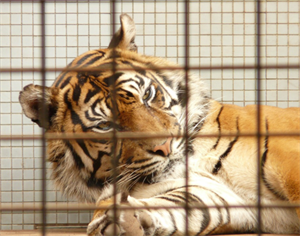
PUMPA - SMART LEARNING
எங்கள் ஆசிரியர்களுடன் 1-ஆன்-1 ஆலோசனை நேரத்தைப் பெறுங்கள். டாப்பர் ஆவதற்கு நாங்கள் பயிற்சி அளிப்போம்
Book Free Demo Of course, it never came to that, but when Timothy was about six months old a change came over him; he grew steadily less friendly. When out for a walk with me, he would try to steal away to stalk a cat or someone’s pet dog. Sometimes at night we would hear frenzied cackling from the poultry house, and in the morning there would be feathers lying all over the verandah. Timothy had to be chained up more often. And finally, when he began to stalk Mahmoud about the house with what looked like villainous intent, Grandfather decided it was time to transfer him to a zoo.
Reserving a first class compartment for himself and Timothy—no one would share a compartment with them—Grandfather took him to Lucknow where the zoo authorities were only too glad to receive as a gift a well-fed and fairly civilised tiger.
About six months later, when my grandparents were visiting relatives in Lucknow, Grandfather took the opportunity of calling at the zoo to see how Timothy was getting on. I was not there to accompany him but I heard all about it when I returned to Dehra.
Arriving at the zoo, Grandfather made straight for the particular cage in which Timothy had been interned. The tiger was there, crouched in a corner, full-grown and with a magnificent striped coat.
As Timothy grew into a full-sized tiger, his behaviour started changing from a tamed cub to a ferocious beast. When he was around six months old, he started taking the characteristics of a wild tiger and leaned towards his original nature. Tigers, in general, are ferocious and meat eating. No amount of taming could suppress the inborn nature of Timothy. He grew less friendly. When the narrator took him out for the usual walk, he started showing a change in attitude.
He started following pet cats and dogs. Although he did not cause any harm to the pets, he would sneak and eat a chicken. The narrator could only hear the scared cackling sound of the chicken trying to escape from the tiger's clutches. In the morning only the feathers of the chicken would remain. Timothy was given the meat of rabbits and pigeons by grandfather. But his wild nature does not permit him to wait patiently for food given at a particular interval of time, and therefore he hunts it down himself. He had to be chained more often because of the fear that he may cause any damage. But things took a turn when the tiger started eyeing Mahmoud the cook with a villainous look and started following him around. When eating animals could be excused, the life of a human being could not be put at risk. Taking this into consideration, the grandfather decides to take the tiger to a zoo.

Tiger catching a chicken
Grandfather had to book a special compartment for him to take the tiger to the zoo. He took the first class compartment all by himself since people were scared to travel along with a tiger. Timothy was taken to the Lucknow zoo where the authorities were happy to see a tiger that was already tamed, healthy and civilized one, compared to the wild and ferocious ones that they usually have to deal with. After six months he goes to the zoo when he is visiting his relatives in Lucknow. He sees the tiger in the same cage he had left him to get trained. By now he is a fully grown tiger with a magnificent striped coat. He sees him crouching in one corner of the cage.

Tiger in a zoo
Words with difficult meaning:
| SI.no | Words | Meaning |
1 | Steadily | In a regular and even manner |
2 | Stalk | To follow someone |
3 | Frenzied | Out of control |
4 | Cackling | A sudden sound |
5 | Poultry | A place where chicken, geese and turkey are reared |
6 | Verandah | A place in front a house, where one can rest |
7 | Villainous | Wicked and evil |
8 | Authorities | Higher officials |
9 | Accompany | To follow or go together with the someone |
10 | Intern | To train someone |
11 | Magnificent | Attractive |
Reference:
National Council of Educational Research and Training (2007). A Tiger in the House - Ruskin Bond (pp. 58- 65). Published at the Publication Division by the Secretary, National Council of Educational Research and Training, Sri Aurobindo Marg, New Delhi.